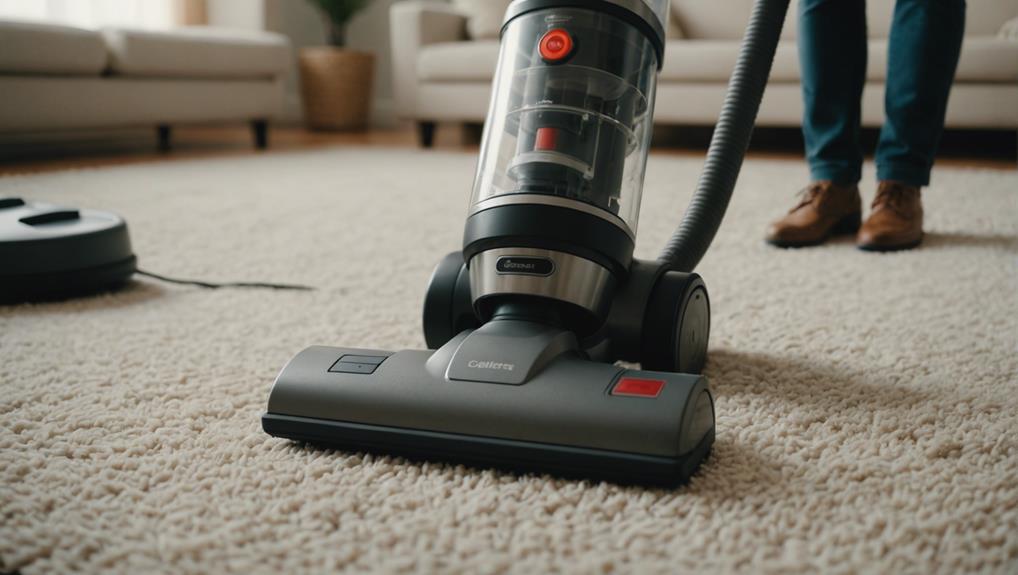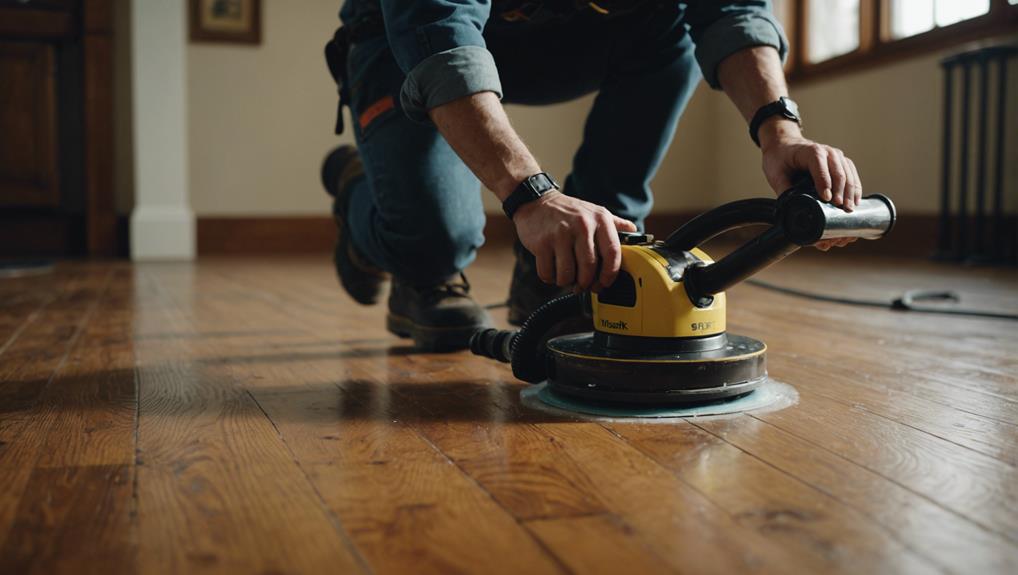When selecting an energy-efficient vacuum cleaner, it is important to consider the wattage and features. Opt for models that have Energy Star certification, as they adhere to high efficiency standards. The wattage typically varies from 100 to 3000 watts, and energy-efficient choices can use up to 50% less power. Advanced features such as automatic shutoff and adjustable suction can significantly improve performance while reducing energy consumption. It is also important to take into account your specific cleaning requirements – upright vacuums are ideal for carpets, while stick models are suitable for quick clean-ups. There is more to explore about maximizing efficiency and cost savings when choosing the perfect vacuum cleaner for your household.
Key Takeaways
- Look for Energy Star certification, indicating high energy efficiency and lower electricity consumption.
- Consider the wattage of the vacuum; models using less than 1000 watts are typically more efficient.
- Regular maintenance, such as cleaning filters and brushes, enhances performance and energy efficiency.
- Evaluate the vacuum type based on your cleaning needs; stick vacuums are generally more energy-efficient for quick tasks.
- Advanced features like automatic shutoff can help reduce unnecessary energy use during operation.
Understanding Vacuum Wattage
When it comes to choosing a vacuum, understanding its wattage can greatly impact your cleaning efficiency. Vacuum wattage typically ranges from 100 to 3000 watts, with modern vacuums averaging around 1200 watts for effective cleaning.
You'll notice that upright vacuums usually consume between 500-3000 watts, while canister models fall in the 1000-1500 watt range, designed for various surfaces. If you're looking for something lightweight and quick, stick or handheld vacuums operate at lower wattages of 100-200 watts.
For pet owners, opting for models like the Bissell Pet Hair Eraser Vacuum can enhance hair removal efficiency, thanks to its self-cleaning brush roll technology.
Now, let's talk about the robot vacuum. These little machines are the most energy-efficient, using only 20-40 watts, making them ideal for light and frequent cleaning.
By understanding vacuum wattage, you can optimize your energy usage, leading to energy savings on your electricity costs. Just remember, higher wattage doesn't always mean better cleaning performance.
It's crucial to evaluate the type of vacuum cleaner and its intended use to find the right balance between power consumption and cleaning ability. This knowledge can help you choose an energy-efficient vacuum cleaner that effectively meets your needs while keeping your electricity bills in check.
Calculating Annual Energy Costs

To calculate your vacuum cleaner's annual energy costs, start by analyzing its power consumption.
Models like the BISSELL CleanView Swivel Upright are known for their budget-friendly efficiency.
By using specific cost calculation methods, you can determine how much you're spending on energy throughout the year.
Understanding these factors helps you manage your household energy efficiency better.
Power Consumption Analysis
Understanding the power consumption of your vacuum cleaner is essential for managing energy costs throughout the year. By analyzing its energy efficiency, you can make informed decisions that affect your annual energy usage.
For example, if you have a 1000W vacuum running for just one hour per week, you'll use about 364 kWh annually. When you factor in the U.S. national average cost of $0.16 per kWh, you can estimate your operating costs easily.
Maintaining a holistic lifestyle approach can also help you manage other household costs effectively. Regular maintenance, like cleaning filters and brushes, helps prevent inefficiencies that can spike your vacuum cleaner energy consumption. If your vacuum has a power consumption of 1500 watts and you use it for two hours monthly, expect annual costs around $38.40.
Opting for models with Energy Star certification can greatly reduce your costs, as these energy-efficient vacuums often consume up to 50% less wattage compared to traditional ones.
Cost Calculation Methods
Calculating the annual energy costs of your vacuum cleaner is straightforward and can help you budget effectively. To determine your vacuum's energy use, use this formula: Power (W) x Daily hours x 7 x 52. For instance, a 1000W vacuum running for 1 hour weekly consumes approximately 364 kWh annually.
| Vacuum Model | Annual Consumption (kWh) | Annual Operating Cost ($) |
|---|---|---|
| 1000W Model | 364 | 76.80 |
| 800W ENERGY STAR® | 291.6 | 62.78 |
| 500W Model | 182 | 38.88 |
With an average U.S. electricity rate of $0.16 per kWh, running a 1000W vacuum for four hours a month costs about $6.40 monthly, leading to $76.80 annually. Multiply your vacuum's annual kilowatt-hours by your local electricity rate to find exact operating costs. By understanding these calculations, you can compare different vacuum models based on their ENERGY STAR® ratings and energy consumption, enabling you to make economical choices for your home.
Importance of Energy Efficiency

Energy efficiency in vacuum cleaners is essential for both your wallet and the environment. By choosing energy-efficient models, you can reduce wattage consumption by up to 50% compared to traditional vacuum cleaners. This significant reduction translates directly into lower electricity costs over time, making your cleaning routine more budget-friendly. One popular option for energy-efficient vacuum cleaners is to invest in toprated cordless vacuums. These models are designed to operate using rechargeable batteries, eliminating the need for continuous electricity consumption while in use. Additionally, many cordless vacuums are equipped with advanced suction power that rivals traditional corded models, making them a powerful and efficient choice for your cleaning needs.
Additionally, adopting energy-efficient appliances, such as air purifiers, can further enhance your home's overall energy conservation efforts.
Many of these energy-efficient vacuums meet Energy Star certification standards, ensuring they use less energy while still delivering high performance. When you maintain your vacuum properly—like cleaning filters and brushes—you can further enhance its efficiency and extend its lifespan.
Opting for vacuums with lower wattage and advanced technology can result in operational costs as low as $0.03 to $0.20 per hour, depending on your local electricity rates. Not only will you enjoy lower utility bills, but you'll also be making a positive impact on the environment by helping to reduce carbon footprints.
Embracing energy-efficient vacuum cleaners promotes environmental sustainability, allowing you to contribute to a greener planet while saving money. Make the switch today, and reap the benefits for both your household and the environment.
Types of Vacuum Cleaners

Selecting the right vacuum cleaner can greatly impact your cleaning efficiency and energy consumption. With various types of vacuum cleaners available, it's crucial to understand their energy usage and suitability for your needs.
For instance, understanding proper maintenance and features of appliances can help improve their performance and longevity, similar to insights on toilet maintenance practices.
Here's a quick overview:
- Upright Vacuum: Powerful but heavier, typically using 500-1,200 watts. Best for carpets and larger areas.
- Stick Vacuum Cleaners: Lightweight and convenient, operating at just 100-200 watts. Ideal for quick clean-ups on hard floors.
- Cordless Vacuum Cleaners: These provide flexibility with a runtime of about 20-60 minutes. While they may have limited power, they're great for quick tasks.
Additionally, you might consider cylinder vacuums for their versatility. They usually consume 1,000-1,500 watts and come with various attachments, making them suitable for different surfaces.
Automated vacuums can also be a smart choice for regular cleaning in small spaces, using only 20-50 watts.
Environmental Benefits of Energy Savings

Choosing an energy-efficient vacuum cleaner isn't just good for your wallet; it's also a step toward a healthier planet. By opting for models that meet Energy Star standards, you can reduce energy consumption by up to 50% compared to traditional vacuums. This means not only lower electricity bills but also a significant decrease in your carbon footprint, as less energy use translates to fewer greenhouse gas emissions.
Additionally, maintaining a clean home environment can contribute to better health, as highlighted by research on cold prevention and immune response.
Many energy-efficient vacuum cleaners are designed with advanced technology that enhances performance while minimizing noise pollution, making them ideal for urban living. Additionally, these vacuums are often constructed from recyclable materials, promoting sustainability and helping to reduce waste in landfills.
Investing in an energy-efficient model may require a higher initial cost, but the long-term savings and potential rebates for Energy Star-rated products make it a smart choice.
Tips for Reducing Energy Usage

To cut down on energy usage while vacuuming, focus on regular maintenance practices like cleaning filters and brushes.
Additionally, consider the benefits of what to look for in a home cleaning service, as efficient cleaning practices can also contribute to energy savings.
You can also optimize your vacuuming schedule and choose energy-efficient models to maximize savings.
Regular Maintenance Practices
Maintaining your vacuum cleaner is essential for enhancing its energy efficiency and overall performance. Regular maintenance not only extends the lifespan of your appliance but also reduces energy consumption.
For instance, keeping your vacuum clean can be as important as using energy-efficient models, which often come equipped with advanced features that improve their performance, similar to how garage door openers enhance home security.
Here are some key practices to keep in mind:
- Clean or Replace Filters: Clogged filters can hinder effective airflow, forcing your motor to work harder and increasing energy usage. Make it a habit to clean or replace them regularly.
- Inspect Brushes and Attachments: Hair and debris can accumulate on brushes and attachments, reducing suction and cleaning efficiency. Regularly check and clean these components to guarantee they function properly.
- Check for Blockages: Minor clogs in hoses and connections can greatly affect performance. Routinely inspect these areas to confirm there are no blockages that could lead to increased energy consumption.
Optimal Vacuuming Schedule
Establishing an ideal vacuuming schedule can greatly reduce your energy usage while keeping your home clean. By scheduling sessions during off-peak electricity hours, you can take advantage of lower rates and cut costs. Focus on high-traffic areas to maximize cleaning effectiveness while minimizing runtime.
To enhance your cleaning routine, consider breaking long vacuuming sessions into shorter bursts. This not only reduces motor strain but also improves energy efficiency. Regular maintenance, like cleaning filters and brushes, will boost your vacuum's performance and lessen the frequency of your sessions.
Additionally, for small messes, use manual cleaning methods to avoid unnecessary vacuum usage and further reduce energy consumption.
Here's a simple table to help you plan your ideal vacuuming schedule:
| Time of Day | Task | Frequency |
|---|---|---|
| Early Morning | Vacuum high-traffic areas | 2-3 times per week |
| Midday | Quick manual cleaning | As needed |
| Evening | Full vacuum session | Once a week |
| Weekly | Maintenance checks | Weekly |
Energy-Efficient Models
When choosing a vacuum cleaner, opting for energy-efficient models can considerably lower your electricity costs while still keeping your home spotless. Additionally, selecting appliances with efficient designs, like those found in Best Airless Paint Sprayers, can contribute to overall energy savings.
Here are three key features to look for:
- Energy Star certification: This guarantees your vacuum meets energy efficiency guidelines and can consume up to 50% less wattage than non-rated models.
- Advanced motor technology: Select models that provide high suction power while using less energy, helping to reduce your electricity bills over time.
- Automatic shutoff features: These prevent unnecessary energy use when your vacuum isn't in operation.
Additionally, consider robotic vacuums, which only consume about 20-50 watts, making them perfect for light, frequent cleaning tasks.
To maintain peak performance, regularly clean filters and brushes, as clogged components can lead to increased energy consumption.
Exploring Jackery Solar Generators

As you explore the world of portable power solutions, Jackery solar generators stand out for their impressive capacity and versatility. Models like the Jackery Solar Generator 2000 Plus and Pro feature high-capacity lithium-ion batteries, offering 2042Wh and 2160Wh. This means you can power various devices, including vacuum cleaners, for extended periods.
Utilizing renewable energy sources like Jackery solar generators aligns with the growing trend towards sustainable energy solutions. When you're using energy-efficient devices, these generators can help you use less energy overall, leading to significant savings on your electricity bills.
With multiple output options, including A.C., USB, and D.C. ports, Jackery solar generators adapt to your needs, whether you're vacuuming indoors or tackling outdoor messes. Their efficient solar charging capabilities allow you to harness renewable energy, reducing reliance on traditional power sources.
This is especially beneficial during camping trips or emergency situations, where accessibility to power is essential. By employing Jackery solar generators, you not only save time but also contribute to an eco-friendly lifestyle.
Choosing the Right Vacuum Model

In today's market, choosing the right vacuum model means balancing efficiency, power, and your specific cleaning needs. To make the best decision, consider these key factors:
- Energy-Efficient Models: Look for vacuums that meet Energy Star certification standards, as they can use up to 50% less wattage than traditional models.
- Type of Vacuum: Decide between upright vacuums, which are great for carpets but can consume 500-1200 watts, and stick vacuums, known for being more energy-efficient at only 100-200 watts.
- Advanced Features: Seek vacuums with variable suction settings and automatic shutoff, which help reduce energy consumption while enhancing cleaning efficiency.
Evaluate the suction power of each model relative to its wattage. For instance, robotic vacuums are incredibly efficient, using just 20-50 watts for light cleaning.
By prioritizing energy-efficient models with advanced technology, you'll not only keep your home clean but also save on electricity bills over time.
Make sure to choose a vacuum that aligns with your lifestyle, ensuring that it meets your cleaning demands while being environmentally friendly.
Frequently Asked Questions
How Many Watts Is Good for a Vacuum Cleaner?
When choosing a vacuum cleaner, look for one that uses around 1,200 watts for effective cleaning.
If you need something for larger areas, an upright model might consume between 500 to 3,000 watts.
For versatility, consider canister vacuums, typically using 1,000-1,500 watts.
If you're after quick clean-ups, stick or handheld vacuums operate at 100-200 watts.
What Specifications to Look for When Buying a Vacuum Cleaner?
When buying a vacuum cleaner, you should look for several key specifications.
First, check the suction power rating, which indicates how effectively it cleans.
Next, consider the weight; lighter models are easier to maneuver.
Look for attachments that enhance versatility, like pet hair tools or crevice nozzles.
You'll also want a model with a good filtration system to trap allergens.
What Is a Good Suction Power for a Vacuum Cleaner?
Imagine a lion's roar—powerful and commanding. That's what good suction power feels like in a vacuum cleaner.
You'll want a model with at least 300 air watts for carpets, ensuring it devours embedded dirt. Canister vacuums usually shine here, offering 300 to 600 watts, perfect for tackling both carpets and hard floors.
What Is the Useful Energy in a Vacuum Cleaner?
The useful energy in a vacuum cleaner relates to its wattage and suction power.
You'll find that typical models range from 500 to 3000 watts, but it's the suction power, measured in air watts, that truly counts.
A vacuum's efficiency hinges on its motor design and maintenance. Regularly cleaning filters and ensuring there's no clog will help maximize the energy output, enhancing your cleaning performance while using less energy overall.
Conclusion
When it comes to vacuum cleaners, you've got a choice: power or efficiency. While a high wattage might promise a deeper clean, an energy-efficient model can save you money and reduce your carbon footprint. Imagine tackling dirt while also protecting the planet—it's a win-win. So, as you choose your next vacuum, remember that the right model doesn't just clean your floors; it cleans up your energy costs and contributes to a healthier environment.









